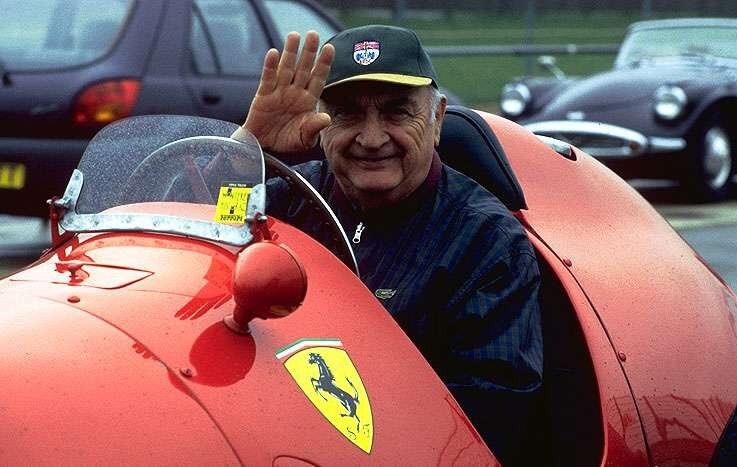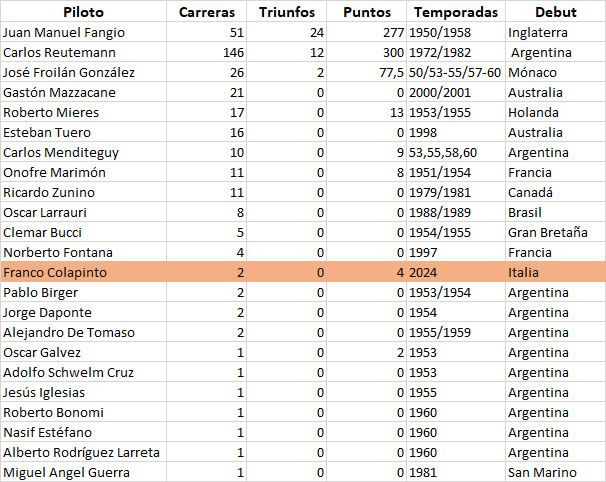
Probablemente este título no sería algo que los médicos y especialistas en genética vean con total convencimiento ya que ellos se fundamentan en la rigurosidad científica; sin embargo, es muy cierto para todos los apasionados del deporte que en ocasiones alguien sobresale y trasciende en alguna especialidad deportiva en buena parte favorecido e incentivado por la historia y la tradición de quienes lo precedieron en esa actividad.
Tenemos muchos casos que así lo demuestran, pero me quiero concentrar en esta oportunidad en el deporte motor, gracias a que ahora está en el candelero Franco Colapinto, un talento en ciernes muy destacable al menos para nosotros los argentinos, ya que hace mucho tiempo que parecía haberse apagado esa llama fulgurante que encendió más de 70 años atrás el superlativo Juan Manuel Fangio.
Estuve investigando y repasando la historia de compatriotas que se sentaron en una butaca de un Fórmula 1, fue muy importante y destacada, principalmente impulsada por ese piloto que marcó una época, en los comienzos de la historia de la categoría.
Pero como otras cosas en la vida, el momento pasó, la fórmula 1 evolucionó y la Argentina involucionó; probablemente allí tendríamos que buscar los motivos por los cuales tuvimos que esperar 23 años para volver a ver un connacional sentado en uno de esos bólidos que tienen la tecnología más avanzada que se pueda encontrar en un automóvil de carreras. No es falta de talento sino falta de recursos económicos y programas de fomento e incentivo para aquellos que habiendo destacado en el medio nacional no pueden llegar a trascender las fronteras. Algo lastimosamente repetido en nuestra Latinoamérica.

Les dejo a continuación una lista de todos los pilotos argentinos que participaron de la F1 y que disputaron al menos una carrera. Historia y tradición que forjaron el carácter y pulieron la técnica y el conocimiento de los más jóvenes, uno de cuyos exponentes se prepara para disputar su tercera carrera en la categoría. La lista está ordenada por cantidad de triunfos, dentro de esta por cantidad de carreras disputadas y luego por cantidad de puntos obtenidos.

Algo que hay que destacar es el tema de los puntos porque ha variado mucho desde aquellos primeros años y hoy en día además de disputar más carreras, también reciben más puntos que antaño. A modo de repaso podemos mencionar que, en los primeros años, desde 1950 hasta 1959 el ganador obtenía 8 puntos y el 5° 2 puntos, allí se terminaba el reparto más 1 punto para el récord de vuelta. Luego en 1960 se agregó un punto para el 6° puesto, pero se quitó el punto de la vuelta rápida. En 1967 se agregó un punto adicional para el ganador pasando a 9; en 1990 se pasó a 10 puntos para el ganador y 8 para el segundo, dejando los 6 tradicionales de esa posición al tercero. En 2003 se agregaron 2 posiciones más puntuables, 2 puntos para el séptimo y 1 para el octavo, desde el 2010 hasta la actualidad el sistema cambió para dar 25 puntos al ganador y desde allí 18, 15, 12 10, 8, 6, 4, 2 y 1 para el décimo en 2019 se agregó nuevamente el esquema de un punto para el récord de vuelta siempre que se encuentre ubicado entre los 10 primeros al finalizar la competencia. Desde 2021 existen en algunas competencias el sistema de carrera sprint que otorga 8 puntos al ganador y desde allí descendiendo en un punto hasta el 8vo. lugar.
De esa lista se desprende una buena cantidad de conclusiones que va más allá de los fríos números, por supuesto eso es motivo de otros artículos y análisis profundos que probablemente no interesen más que a los que amamos el deporte motor, su historia y las historias individuales los que forjaron el pasado y los que comienzan a andar el camino ahora.
Sports genes
This title would probably not be something that doctors and geneticists would see with total conviction, since they are based on scientific rigor; however, it is very true for all sports enthusiasts that sometimes someone stands out and transcends in some sports specialty, largely favored and encouraged by the history and tradition of those who preceded them in that activity.
We have many cases that demonstrate this, but I want to concentrate on motorsports this time, thanks to the fact that Franco Colapinto is now in the spotlight, a very notable emerging talent at least for us Argentines since it seemed a long time ago that dazzling flame that was lit more than 70 years ago by the superlative Juan Manuel Fangio had gone out.
I was researching and reviewing the history of compatriots who sat in a Formula 1 seat, it was very important and outstanding, mainly driven by that driver who marked an era, at the beginning of the history of the category.
But like other things in life, the moment passed, Formula 1 evolved and Argentina regressed; probably there we would have to look for the reasons why we had to wait 23 years to see a fellow countryman sitting in one of those cars that have the most advanced technology that can be found in a racing car. It is not a lack of talent but a lack of economic resources and programs to promote and encourage those who, having stood out in the national environment, cannot transcend borders. Something unfortunately repeated in Latin America.
Below is a list of all the Argentine drivers who participated in F1 and who contested at least one race. History and tradition forged the character and polished the technique and knowledge of the youngest, one of whose exponents is preparing to contest his third race in the category. The list is ordered by victories, then by number of races contested, and then by number of points obtained.
Something that should be highlighted is the issue of points because it has changed a lot since those early years and today, in addition to competing in more races, they also receive more points than before. As a review, we can mention that, in the early years, from 1950 to 1959, the winner received 8 points and the 5th 2 points, which was the end of the distribution, plus 1 point for the lap record. Then, in 1960, a point was added for 6th place, but the point for the fastest lap was removed. In 1967, an additional point was added for the winner, increasing to 9; in 1990, it was increased to 10 points for the winner and 8 for the second, leaving the traditional 6 for that position for the third. In 2003, 2 more scoring positions were added, 2 points for seventh and 1 for eighth. From 2010 to the present, the system changed to give 25 points to the winner and from there 18, 15, 12 10, 8, 6, 4, 2 and 1 for the tenth. In 2019, the one-point scheme for the lap record was added again as long as it is located among the top 10 at the end of the competition. Since 2021, there has been a sprint race system in some competitions that awards 8 points to the winner and from there descends by one point to 8th place.
From that list, many conclusions emerge that go beyond the cold numbers. Of course, that is the subject of other articles and in-depth analyses that probably will not interest anyone other than those who love motorsport, its history, and the individual stories of those who forged the past and those who are beginning to walk the path now.
Héctor Gugliermo
@hosgug